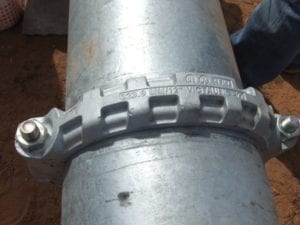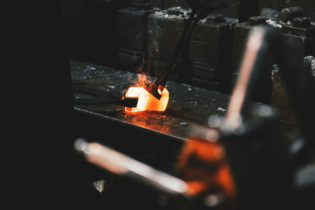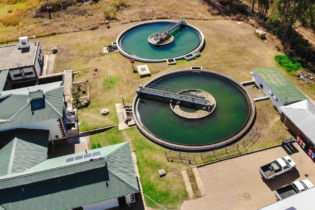A new Sedibeng Water Board pipeline installation is set to become the benchmark for rapid and robust piping installations for municipal water supplies and similar applications in South Africa.
After the discovery of leakages in a major 500-mm diameter welded pipeline serving the Springbok area, the Sedibeng Water Board chose BVi Consulting Engineers to design the rehabilitation and replacement work on the existing main water supply pipeline. As a temporary replacement for part of the ageing but vital 54-km long pipeline, a 14 km bypass surface pipeline was designed for continuous water supply over difficult terrain. It involved 300 mm carbon steel medium pipe (300 NB) on concrete plinths. BVi, acting first as project manager and later as consultant, relied on Victaulic grooved mechanical pipe joining solutions to ensure continuous water supply to local areas. Employing Victaulic products allowed fast installation using local labour, and delivered considerable benefits over the flanged or welded alternative. Alternative choice Traditionally, flanged or welded piping would be used on such a water distribution pipeline. However, the decision to install a grooved mechanical piping system from Victaulic was based on the speed and ease of installation and the flame-free assembly this allowed, resulting in savings on total installed cost. Not only was the Victaulic system faster to install, but its ease of assembly allowed the use of a local workforce and created jobs in the area. Another key advantage that the mechanical pipe joining system offers is that it enables rapid assembly and disassembly, making tasks such as maintenance and system rerouting considerably more convenient. Some of the major advantages of installing Victaulic products are derived from their simplicity – the design of a mechanical pipe joint is inherently easier to work with during installation than other more traditional joining methods. A mechanical joint, or coupling, is comprised of four basic but robust elements: the pipe groove, gasket, coupling housings, and nuts and bolts. A pipe groove is formed by cold forming or machining a groove into the end of a pipe – using an easy-to-use Victaulic grooving tool, it is possible to do this on-site, as at Sedibeng, or off-site in a workshop enabling prefabrication. The coupling gasket is pressure responsive and is encased by the coupling housing when it engages in the groove around the circumference of the pipe. The gasket then creates a seal unified joint that is enhanced when the system is pressurised. Grooved piping systems are dramatically faster and easier to assemble than their welded or flanged equivalents. Systems in which Victaulic products are installed are also considerably faster to disassemble than other pipe joining methods, with dramatic time and labour savings. At Sedibeng, this meant that while the process of replacing or rehabilitating the existing main line was in progress, the temporary bypass line could be assembled – and in a fraction of the time of a welded or flanged system. In the future, once the original line is replaced and fully functional, the bypass may then be dismantled in a fraction of the time taken by a more traditional joining method. Parts can then be reused. BVi specified 300 mm Victaulic Style 77 flexible couplings on the project and 2 333 couplings were subsequently installed. Victaulic Style 77 flexible couplings feature a two-piece design that creates a flexible joint while also reducing handling, and enabling easier and quicker installation. The couplings can withstand pressures of up to 800 psi/5500 kPa and are commonly used for a variety of industrial applications, including water and air applications. The main reason why BVi specified Style 77 flexible couplings is that, over time, terrain may be subject to displacement and ground movements, creating potential stress on pipework and even resulting in breakages. All these stresses are difficult for engineers to manage. Flexible couplings are especially designed to allow controlled linear and angular movement at each joint that can accommodate pipeline deflection. They offer security while also accommodating potential misalignments without the need to install the expensive and delicate specialised equipment, which is necessary with flanged or welded systems. “It did not take long to convince the Sedibeng Water Board, which soon realised the benefits of the Victaulic grooved system,” says BVi consulting engineer Winston Cloete. “The system clearly delivered significant advantages. We were all confident it was the right choice.” The ability to offer a totally secure leak-free joint, speedy installation and ease of maintenance secured the decision.“I would definitely use the Victaulic system again in a flash,” comments Cloete.
Contractor view Contractor NMC North was awarded the contract to install the pipework after a successful tender. The company had worked closely before with both the Sedibeng Water Board and BVi. “The biggest challenge from our perspective was the difficult terrain,” says Dallas van der Westhuyzen, contract manager with NMC North. “Once the installation started, we realised very quickly just how easy and fast the work could be completed with Victaulic couplings, despite the uneven ground.” For the local crew, learning to use the grooving tools and couplings was extremely easy. Training lasted under an hour, and right from the start teams were taking only 10 minutes to complete a perfect joint. On average, the crews were completing 25 lengths of 6 m pipe per day, and by the end of the project they were reaching an astounding 37 pipe lengths per day. The entire initial 6.5 km pipe run was completed on time, although challenges occurred with the delivery of materials from other suppliers. In addition, the next phase of 7.5 km was completed four weeks earlier than the anticipated completion date A flanged system would have required around 16 M30 bolts and nuts to be installed and tightened at each joint, and the handling of the pipe would have been more difficult due to the added weight. The Victaulic grooved system offered the added advantage of reducing health and safety risks. As less time is spent on the joint there is less exposure to work site risks, reducing likelihood of injuries to fingers, compared with installing a flanged system. The crew also found it very easy to check if installation was correct and the joint was in place securely – simply by looking at the bolt pads and making sure they met each other without any gaps. Conclusions In Sedibeng, installing a Victaulic grooved system made for easier maintenance, reduced material handling and risk of injury to workers on-site, as well as total installed cost. “The grooved system saved substantially on labour and I cannot imagine reaching the same productivity level with a flanged or welded system,” maintains Van der Westhuyzen. “The Victaulic team also provided full support with on-site training, continued site visits and technical support. “I am convinced that this is the fastest, easiest and trouble-free way to join pipes,” adds Cloete. “And I can see the considerable maintenance advantages this will offer the Sedibeng authority in the future. We will recommend this method for our future projects, and look forward to working with Victaulic again soon.”







